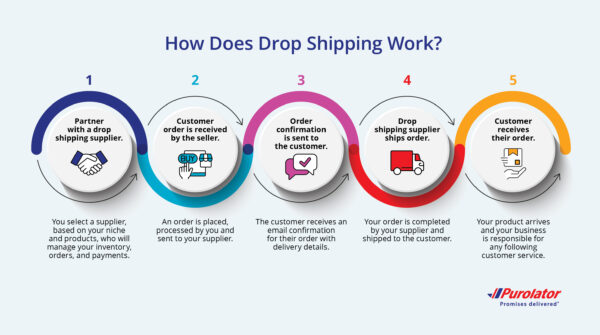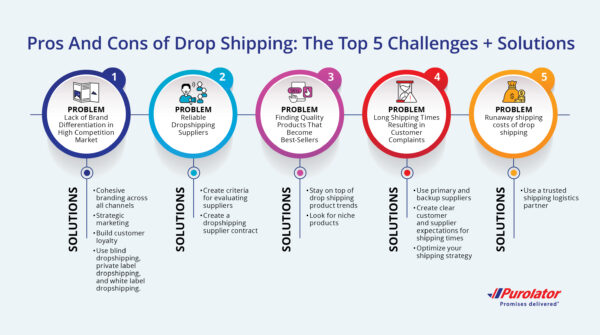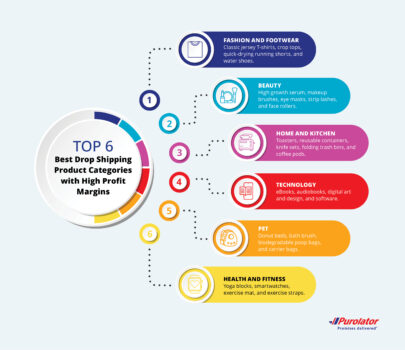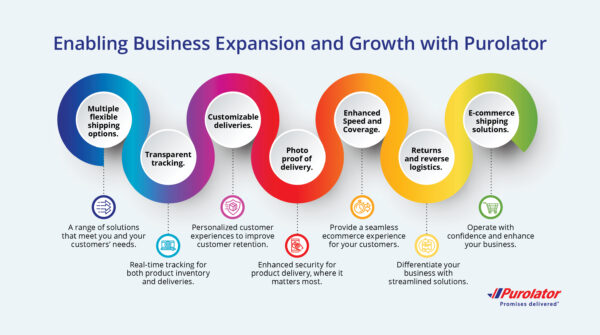Drop shipping is a popular type of retail e-commerce business model with low overhead, where the business owner does not keep stock on hand and is not responsible for managing inventory. Drop shipping can be simple and easy, and its appeal has grown over the years. In fact, it’s forecasted that the worldwide drop shipping market size will grow from $175.4B (2020) to $649.2B by 2026.
However, there are some pros and cons of drop shipping that need to be considered. In this article, we’ll cover what you need to know about drop shipping, including solutions to the top challenges, key benefits, trending products and product categories with high profit margins, as well as how to evolve your drop shipping business as it grows.
In this article, we’ll explore the following questions and concepts:
- What is drop shipping?
- What is “blind drop shipping”, “private label drop shipping”, and “white label drop shipping”?
- Is drop shipping legal?
- How profitable is drop shipping?
- Pros and cons of drop shipping: The top 6 benefits
- Pros and cons of drop shipping: The top 5 challenges + solutions
- How to start drop shipping: 7 key steps
- How to select the best drop shipping suppliers
- How to find trending products for drop shipping
- Top 6 best drop shipping product categories with high profit margins
- Evolving Your Drop Shipping Business with a Shipping Fulfillment Partner
- Enabling Business Expansion and Growth with Purolator
What is drop shipping?
Drop shipping is an e-commerce business model where you sell products to customers while outsourcing your procurement, storing, and shipping while removing operation costs that come with wholesale.
How does drop shipping work?
- You partner with a drop shipping supplier. You select a supplier, based on your niche and products, who will manage your inventory, orders, and payments.
- Customer order is received by the seller. An order is placed, processed by you and sent to your supplier.
- Order confirmation is sent to the customer. The customer receives an email confirmation for their order with delivery details.
- Drop shipping supplier ships order. Your order is completed by your supplier and shipped to the customer.
- Customer receives their order. Your product arrives and your business is responsible for any following customer service.
What is “blind drop shipping”, “private label drop shipping”, and “white label drop shipping”?
Blind drop shipping – The supplier is kept anonymous, so the product appears as if it came directly from your business.
Private label drop shipping – Your supplier manufactures exclusively with your business to create products with your own branding rather than generic items.
White label drop shipping – Your supplier manufactures generic products with your branding, but they are not exclusive to you and may do the same for several other retailers.
Is drop shipping legal?
Yes, drop shipping is legal. As long as your products are legally sellable, drop shipping is typically low-risk. Just make sure that you’re following local, national, and international regulations and laws such as:
- Copyright laws
- Consumer protection laws
- Truth in advertising laws
- Tax and licensing laws
How profitable is drop shipping?
Drop shipping can be a profitable e-commerce business, but its success depends on factors like your brand, suppliers, and products. Generally, profit margins are healthy for a small dropshipping business at 15-25%, but it depends on the products you’re selling. We’ll cover the best drop shipping products with high profit margins later.
Pros and cons of drop shipping: The top 6 benefits
- Lower startup costs. Without inventory or the warehouse management, there is a low initial investment. Drop shipping is also easy to start with just a computer.
- Instant product availability. Rather than waiting for product inventory to ship into a warehouse, dropshippers can begin advertising and offering products to customers immediately.
- Wider selection of products. Your product catalogue can be updated as soon as new items enter the supplier’s database. Dropshippers also avoid the financial risk of unsold stock
- Location flexibility. As long as you have access to the internet, you can start your business from anywhere, increasing accessibility.
- Low risk for testing new products. Not needing to buy inventory, store, or deal with shipping logistics means it’s easy to test the popularity of products with your customers without financial risk.
- Increased scalability. Using a supplier means added ease to grow your business and meet unexpected demand. You can accommodate orders and expand reach to other marketplaces.
Pros and cons of drop shipping: The top 5 challenges + solutions
Here are the common cons to drop shipping, and solutions to address these risks.
-
Lack of Brand Differentiation in High Competition Market
Drop shippers are often offering the same products, so it’s hard to stand out and increase brand awareness as a business.
SOLUTIONS:
- Cohesive branding across all channels. Focus on a robust brand strategy with consistent messaging, branding, and design to create a seamless, memorable brand.
- Strategic marketing. Use influencer marketing, email marketing, and PPC advertising that understands your unique audience’s needs, wants, and demographic. Leverage social media where possible–drop shipping businesses with at least one social media account generate 32% more revenue than those without.
- Build customer loyalty. Meet customer expectations with timely shipments, products that arrive safely and undamaged, personalized customer experiences, and great customer service that encourages repeat purchases. Here’s how a delivery provider can enhance your brand loyalty.
- Use blind dropshipping, private label dropshipping, and white label dropshipping. Take advantage of these types of dropshipping that add customization to reinforce your brand in your customer’s buying experience to encourage repeat purchases.
-
Reliable Drop Shipping Suppliers
You may run into unreliable suppliers that can’t meet customer demand, don’t ship items in a timely manner, and have unpredictable stock.
SOLUTIONS:
- Create criteria for evaluating suppliers. Before signing a contract, evaluate suppliers based on:
– Their reviews
– Their policies (return policy, shipping agreements, etc.)
– Warehouse location and proximity to your market
– Minimum order requirement (ideally, no minimum order)
- Create a drop shipping supplier contract. Include service level agreements like:
– Agreed product pricing
– Guidelines for returns and refunds
– Chargebacks
– E-commerce shipping fraud prevention
– Systems and Sanctions for contract breach
- Create criteria for evaluating suppliers. Before signing a contract, evaluate suppliers based on:
-
Finding Quality Products That Become Best-Sellers
Finding best-selling products is important to stay competitive, but it can be difficult and time-consuming.
SOLUTIONS:
- Stay on top of drop shipping product trends. Complete a market analysis of top product categories and use the “Best Sellers” list on suppliers’ websites to choose products that solve for your customers’ needs and drive demand.
- Look for niche products. Take advantage of lightweight, rare products with unique features that occupy a niche and differentiate you from what’s typically sold in brick and mortar stores.
-
Long Shipping Times Resulting in Customer Complaints
Depending on your supplier, you may have low profit margins, which means the quality of your fulfillment and delivery will be most important. If your products don’t ship on time, you won’t be meeting your customer expectations, and your customer retention and brand loyalty will suffer.
SOLUTIONS:
- Use primary and backup suppliers. This way, if one falls through, you won’t be scrambling to fulfill orders or worrying about business impact on your hard-earned customers.
- Create clear customer and supplier expectations for shipping times. Make shipping policies on the customer and supplier side as clear as possible. Prepare your business for surge times, such as the holiday season.
- Optimize your shipping strategy. Choose a supplier with a variety of shipping options and warehouses where your customers are located to ensure speed of delivery. Where possible, look into how to make free shipping work for your business.
-
Runaway Shipping Costs of Drop Shipping
As your dropshipping business grows, you may start working with multiple suppliers and begin shipping overseas. This can result in delivery delays, poor tracking, and tariffs unique to each country, which can contribute to high costs and poor customer retention. In fact, for 69% of consumers, late delivery means they are much less likely or less likely to shop with a retailer. In comparison, 96% of consumers say that positive delivery experiences encourage them to shop at the retailer again.
SOLUTION:
- Use a trusted shipping logistics partner. If your drop shipping business is growing to the point you are managing multiple different suppliers and orders and you are no longer a small business with a niche product, it may be time to start shipping on your own. Consider a trusted shipping fulfillment partner with a wide network, like Purolator, that offers expertise in this area.
How to start drop shipping: 7 key steps
Even with its challenges, drop shipping can be a rewarding business. Here are the key steps to starting your own drop shipping business.
(1) Decide if drop shipping is right for your business. Ask yourself these questions:
- Do you have a strong marketing and branding expertise to help you stay competitive?
- Are you looking for an entrepreneurial venture with minimal startup costs?
- Do you have an eye for stand-out products and creating flagship products?
- Do you feel prepared to take on the risks of dropshipping?
- Will your product thrive in a drop shipping model, or is it better suited for alternate delivery options?
(2) Select a product niche. Choose a drop shipping niche that aligns with your expertise and interests, with high demand and low competition. Learn how to find trending products here.
(3) Complete competitor research. Find competitors in your niche using a competitor analysis tool, Google, and marketplaces. Review their marketing, product pages, and social media to fine-tune your strategy.
(4) Create your drop shipping business plan. Include elements such as:
- Executive Summary
- Company Description
- Products and Services
- Market Analysis
- Strategy and Implementation
- Organization and Management
- Financial Plan and Projections
(5) Select a dropshipping supplier. Use supplier directories to locate what suppliers are available with a network large enough to reach your customer base, while also offering niche products and timely shipping. Here’s how to find the best drop shipping suppliers.
(6) Create your dropshipping marketing strategy. Include marketing strategies for both the short term (PPC ads, social media ads, influencer marketing, video marketing) and long term (email campaigns, content marketing, SEO marketing to rank in Google SERPs).
(7) Choose and price your products. Use your audience’s needs, wants and their demographic to create your product inventory and anticipate upselling and cross-selling opportunities. We also recommend using these strategies to streamline your checkout process, and encourage purchase completion.
How to select the best drop shipping suppliers
Your supplier is a big contributor to the success of your business. Here’s how to pick the best drop shipping suppliers.
- Product Quality. Ask for a sample of the supplier’s products. When you receive it, review the product description, if the product functions as intended, any imperfections or scratches, and how it is packaged.
- Shipping Times. Look for a supplier with reasonable shipping standards and costs. Ideally, you’ll want suppliers that can fulfill orders in 24 hours.
- Return Policies. Review their policies and make sure the supplier can manage returns in a timely manner and will refund your money to you. This is a great opportunity to also make sure you have a robust e-commerce return process that your customers are aware of.
- Warehouse Location. To reduce international order shipping times, look for a dropshipping supplier with warehouses in your customer base’s area.
- Competitive Pricing. Look for suppliers with the most affordable price by using a picture of the product and completing a Reverse Image search on Google.
How to find trending products for drop shipping
- Use social media. Pinterest, Instagram, TikTok, YouTube, Reddit, and Facebook can help you identify trending products with a unique selling point where the market isn’t saturated.
- Complete keyword and market research.
– Keyword research: Use tools like Google Trends to see historic interest and search volume for product keywords.
– Market research: Use product researching tools like SalesSource, Dropship Spy, Niche Scraper, and Sell the Trend. Look for products with high profit margins. - Monitor customer reviews. This is a source of valuable information for your business. Use reviews to identify new and growing needs and wants with your audience
Top 6 best drop shipping product categories with high profit margins
The drop shipping product segment with the strongest projected growth is fashion, at 35.6% by 2031. With a rising demand for branded products, ease of price comparison, and convenient shipping and returns, here are the top 6 best drop shipping products with high profit margins:
- Fashion and footwear: Classic jersey T-shirts, crop tops, quick-drying running shorts, and water shoes.
- Beauty: High growth serum, makeup brushes, eye masks, strip lashes, and face rollers.
- Home and Kitchen: Toasters, reusable containers, knife sets, folding trash bins, and coffee pods.
- Technology: eBooks, audiobooks, digital art and design, and software.
- Pet: Donut beds, bath brush, biodegradable poop bags, and carrier bags.
- Health and Fitness: Yoga blocks, smartwatches, exercise mat, and exercise straps
Evolving Your Drop Shipping Business with a Shipping Fulfillment Partner
As your drop shipping business grows, you will need to adjust your shipping strategy to meet demand. The best way to do this is to use a shipping fulfillment partner, which comes with benefits such as:
- Improved shipping efficiency
- Access to trusted expertise and resources
- Competitive advantage in a saturated market
- Savings based on shipping volume
- Exclusive benefits based on business profile
- Increased reliability and risk preparedness
- Heightened quality control
- Greater customer satisfaction and retention
Direct Ship Vendor Solutions – A Hybrid Drop Shipping Business Model
With a shipping fulfillment partner, it may make sense to move your drop shipping model into a direct ship vendor solution, which is a hybrid version of drop shipping where you leverage the services of your shipping partner to manage your product suppliers. Once you have a complete list of your products, your logistics provider will determine which ones can benefit from a direct ship vendor solution based on volume, product characteristics, and cost-effectiveness.
There are many benefits of direct ship vendor solutions including:
- Lower costs for inventory and warehouse management
- Expansion of product offerings without inventory maintenance
- More flexibility over products
- Increased speed for deliveries
- Access to special handling and dangerous goods services for products
- Specialized shipping services and shipping fulfillment process managed fully by trusted expert
Enabling Business Expansion and Growth with Purolator
Consistently recognized as one of the most trusted brands in delivery service, Purolator’s capabilities are built to support drop shipping businesses, direct vendor solutions, and your broader business growth.
Purolator has the largest number of operational terminals in Canada, delivering to 100% of all Canadian postal codes, with packages getting to their destination one day faster than the competition. As a single-solution international services provider, Purolator’s expertise and network helps simplify import and export for businesses. Partnering with Purolator enables your business for growth through solutions like:
- Multiple flexible shipping options. A range of solutions that meet you and your customers’ needs.
- Transparent tracking. Real-time tracking for both product inventory and deliveries.
- Customizable deliveries. Personalized customer experiences to improve customer retention.
- Photo proof of delivery. Enhanced security for product delivery, where it matters most.
- Enhanced Speed and Coverage. Provide a seamless ecommerce experience for your customers.
- Returns and reverse logistics. Differentiate your business with streamlined solutions.
- E-commerce shipping solutions. Operate with confidence and enhance your business.
Start Your Drop Shipping Business The Right Way
As you consider the pros and cons of drop shipping, remember that this e-commerce business model can be lucrative with an optimized strategy and the right products. As your customer base grows, consider other shipping methods and different business models like a direct ship vendor solution. In a hyper saturated market, customer satisfaction and retention is a crucial differentiator. This means fine-tuning your shipping logistics by partnering with trusted shipping fulfillment partners, like Purolator.




